
April 4, 2005
|
 |
Wheat
Wheat has little resistance to low temperatures after it begins growing in the spring, therefore, injury from freezes at this time can occur. The following six questions cover wheat injury symptoms at different spring growth stages. The amount of injury may be large or only a few fields or parts of fields. It is most severe along river bottoms, valleys, and depressions in fields where cold settles.
Wheat is most sensitive to freeze injury during reproductive growth which begins with pollination during late boot or heading stages. Temperatures that are only slightly below freezing can severely injure wheat at these stages and greatly reduce grain yields.
Question #1
My wheat is in the joint stage and temperatures were below the critical 24 degrees for several hours. What kind of plant injury would I expect to see?
It is important to know the plant parts that are most vulnerable at each growth stage, where they are located on the plant, and their appearance when they are normal as well as when they have been injured.
The jointing stage of wheat usually occurs from late March through April. |
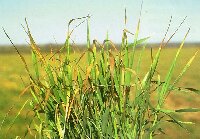
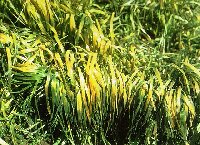 |
Leaves of freeze-injured plants. |
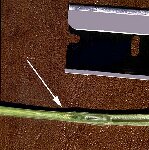  
 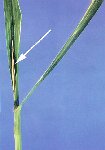
|
The most serious injury occurs to the growing points. The growing points can be located by splitting stems longitudinally with a sharp blade . A normal, uninjured growing point is bright yellow-green and turgid; freeze injury causes it to become white or brown and water soaked in appearance. This injury can occur even in plants that appear otherwise normal because the growing point is more sensitive to cold than that of other parts. Growth of stems in which the growing points are injured stop immediately. A chlorotic or dead leaf may appear in the whorl, indicating that the growing point is dead. Growth from later uninjured tillers may obscure damage. Partial injury at this stage may cause a mixture of normal tillers and late tillers and result in uneven maturity and some decrease in grain yield. |
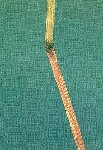 |
Injury to the lower stems in the form of discoloration, roughness, lesions, splitting, collapse of internodes, and enlargement of nodes frequently occurs at the jointing stage and the following stages after freezing. Injured plants often break over at the affected areas of the lower stem so that one or two internodes are parallel to the soil surface. |
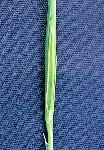  |
Stem injury does not appear to seriously interfere with ability of wheat plants to take up nutrients from the soil and translocate them to the developing grain. Injured areas might become infected by micro-organisms which can cause further stem deterioration. Lodging (falling over) of plants is the most serious problem following stem injury. Wind or hard rain can easily lodge the plants, deceasing grain yields and slowing harvest. With severe stem injury, splitting of stems and collapse of internodes is common. |
Question #2
My wheat is in the boot stage and temperatures were below the critical 28 degrees for several hours. What kind of plant injury would I expect to see?
It is important to know the plant parts that are most vulnerable at each growth stage, where they are located on the plant, and their appearance when they are normal as well as when they have been injured. |

 |
Leaves of freeze-injured plants. |
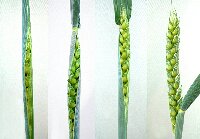  |
Freeze injury at this stage, when the heads are enclosed in the sheath or the flag leaves, causes a number of symptoms. Freezing may trap the head inside the boots so that they cannot emerge normally. When this happens, the heads will remain in the boots, split out the sides of the boots, or emerge base-first from the boots. |
 |
Sometimes spikes emerge normally from the boot after freezing, but remain yellow or even white instead of their usual green color. When this happens, the heads have been killed. |
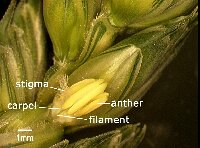
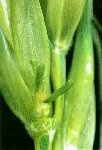




|
Frequently, only the male parts (anthers) of the flowers in the head are killed. Since wheat is self-pollinated, sterility caused by freeze injury causes poor kernel set and low grain yield. Injury can be detected soon after freezing by examining the anthers inside each floret. Anthers are normally light green and turgid when young and become yellow about the time they are extruded from the florets after anthesis or flowering. The anthers, still green, become twisted and shriveled within 48 hours after a freeze, but they turn white to whitish-brown quickly and may not be extruded from the florets. The female parts (stigma, style, and ovary) may be damaged, but if they are, the anther also will be injured. The stigma normally has a greenish-white, feathery appearance. A damaged stigma becomes off-white to brown and will not open. The ovary will also turn off-white to brown. Use of a hand lens will be helpful in detecting symptoms. |
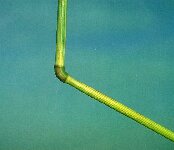 |
Many symptoms of freeze injury that occur at early stages might also be present at the boot stage. Leaves and lower stems might exhibit symptoms described for the jointing stage, but these plant parts are less sensitive than are the male flower parts. It is important, for this reason. to examine the anthers. Freezing temperatures that are severe enough to injure leaves and lower stems are nearly always fatal to male flower parts, but less severe freezing may cause male sterility without any symptoms appearing on plant vegetative parts (leaves and stems). |
Question #3
My wheat is in the heading stage and temperatures were below the critical 30 degrees for several hours. What kind of plant injury would I expect to see?
It is important to know the plant parts that are most vulnerable at each growth stage, where they are located on the plant, and their appearance when they are normal as well as when they have been injured. |

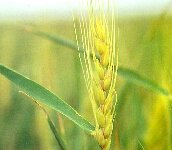 |
Wheat heads usually emerge from the boots during the first two weeks of May. Most symptoms of freeze injury at this stage are sterility, leaf desiccation or drying. Lesions on lower stems have symptoms that are similar to those at earlier growth stages. The most apparent symptom, however, is usually chlorosis or bleaching of the awns ("beard") so that they are white instead of the normal green color. Freezing temperatures that injure the awns will usually kill the male flower parts. |
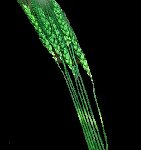 |
A light green or white "frost ring" may encircle the stems one to two inches below the heads several days after exposure to freezing temperatures. This area of yellowed chlorotic tissue marks the juncture of the stems and the flag leaves at the time that the freeze occurred. The frost ring may be present on injured plants as well as on plants that show no other symptom of injury. It does not seem to interfere with movement of nutrients from the plant to the developing grain. As the plants mature the heads may break over at the frost ring. That is most likely to happen to heads that are well filled, particularly during windy conditions. |
Question #4
My wheat is in the flowering stage and temperatures were below the critical 30 degrees for several hours. What kind of plant injury would I expect to see?
It is important to know the plant parts that are most vulnerable at each growth stage, where they are located on the plant, and their appearance when they are normal as well as when they have been injured.
Wheat usually flowers about one week after the heads appear. Symptoms of freeze injury at the flowering and heading stages are nearly similar.
The flowering stage is the most freeze-sensitive stage in wheat. Small differences in temperature, duration of exposure, or other conditions can cause large differences in amount of injury.
Exposure to freezing temperatures at the flowering stage kills the male parts of the flowers and causes sterility as described for the boot and heading stages. After freezing, the anthers are white and desiccated or shriveled instead of their normal yellow color.
Freeze injury at the flowering stage causes either complete or partial sterility, and void or partially filled heads because of the extreme sensitivity. |
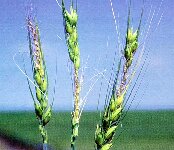 |
Flowering proceeds from florets near the center of wheat heads to florets at the top and bottom of the heads over a 2 to 4 day period. This small difference in flowering stage when freezing occurs may result in no grain being set in the center or one or both ends of the head. This lack of grain set may have resulted from male flowers in those florets being in a sensitive growth stage when the freeze occurred. Grain might develop in other parts of the spikes, however, because flowering had not started or was already completed in those florets when the freeze occurred. |
Question #5
My wheat is in the milk stage and temperatures were below the critical 28 degrees for several hours. What kind of plant injury would I expect to see?
It is important to know the plant parts that are most vulnerable at each growth stage, where they are located on the plant, and their appearance when they are normal as well as when they have been injured. |
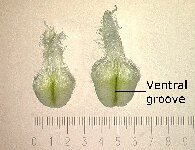


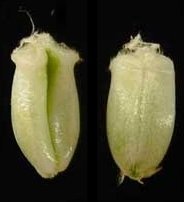
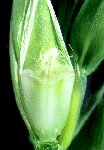
 |
Young developing kernels normally grow to full size (volume) within 12 to 14 days after flowering, but maximum grain weight is not reached for another two weeks. If young kernels fail to develop after freezing temperatures occurred, they likely have been injured. Injured kernels may be white or gray and have a rough, shriveled appearance instead of their normal light green, plump appearance. Cool weather frequently delays these other symptoms and failure of kernels to develop may be the major indication of injury. |
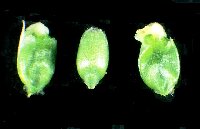 |
Kernels that are slightly injured at the milky ripe stage may grow to normal size, but produce light, shriveled grain at maturity. Examination of the kernels before maturity, at the early dough stage, may show that their contents are grey and liquid instead of white and viscous as they should be at this stage. The interior of the rachilla, the small stems that attach the spikelets to the stems, may also be dark instead or light-colored, so that the spikelets are easily stripped from the stems. These symptoms result from gradual deterioration of tissues and usually do not show up for a week or more after freezing occurred. |
| Wheat that has been injured by freezing at the milky-ripe stage often shatters easily at maturity, and the shriveled kernels cause the grain to have a low test weight. Germination percentage of the grain also may be seriously reduced as a result of freeze injury. |
Question #6
My wheat is in the dough stage and temperatures were below the critical 28 degrees for several hours. What kind of plant injury would I expect to see?
It is important to know the plant parts that are most vulnerable at each growth stage, where they are located on the plant, and their appearance when they are normal as well as when they have been injured.
Wheat kernels reach full size and nearly full weight by mid-dough stage in late May to early June. Because kernel development is nearly complete and kernel moisture content may have decreased, wheat is usually more resistant to freezing temperatures at this stage than at most earlier spring growth stages. The only visible sign of freeze injury at the dough stage may be an unsightly wrinkled appearance of the kernels and a slightly reduced test weight.
The most serious consequence of freeze injury at the dough stage is reduced germination of kernels. The embryo or germ usually has a higher moisture content than other kernel parts, and its' complex cellular content and structure makes it more vulnerable to freezing. |
Question #7
What should I do with wheat that has been injured by a freeze, but I still want to harvest the grain?
Freezing frequently injures only part of the wheat head or only plants in certain parts of fields such as depressions and low areas. In addition, late tillers that normally would not produce significant grain may develop rapidly after a freeze, particularly when it occurs at early spring growth stages. These late tillers may produce appreciable yields if weather conditions following the freeze are suitable. Freezes at late spring growth stages would result in late tiller being developed in hot and dry conditions which usually prevent them from producing worthwhile yields.
When freeze injury is only partial and alternate management practices might disrupt established rotation systems or when good alternate uses of crops are not available, then the best management practice might be patience. Except in the most severe cases, wheat that has been injured often produces yields that exceed harvesting and hauling costs. This might be offset somewhat by the possibility of lodging caused by lower stem damage. Lodged plants slows harvest and increases shattering losses.
Grain produced by wheat injured after the flower stage frequently is of poorer quality than usual. Test weight may be low, kernels may be shriveled or discolored, and the grain may be a mixture of kernels of different sizes and maturities.
The germination percentage of grain from freeze-injured plant that is to be used for seed should be checked before planting. Grain of most wheat varieties has a natural dormancy that causes low germination for several weeks after harvest. The grain should be given a cold treatment before testing, or germination tests should be delayed for almost four weeks. If germination is slow and germination percentage is low for four weeks or more after harvest, the wheat should not be used as seed. Shriveled seed should not be used in any case because field emergence is poor even if germination parentage is high. In addition, shriveled seeds produce less vigorous seedlings that usually yield less grain than seedlings from good quality wheat seed.
Wheat grain that is shriveled or germinates poorly can still be used as cattle feed. It is usually high in protein content, which enables the amount of protein from other sources to be decreased. Wheat grain should be gradually incorporated into the livestock ration over a one-week period and, in no case, should it constitute more than one-third to one-half of the total grain in the ration.
In order to make the decision to keep or abandon a field of wheat, a farmer needs to estimate potential yield (handout on yield estimation in wheat). |
Question #8
What should I do with wheat that has been seriously damaged by a freeze?
Producers should evaluate the field for total freeze loss before abandoning the crop. The degree of freeze injury varies greatly with elevation in a given field. In many cases, low lying areas in a field may have severe injury, while the upper end of the same field may have little apparent injury. Strategic use of a hot wire may allow a significant amount of grain harvest, while utilizing freeze injured wheat as forage. This requires careful scouting.
If damage is wide spread enough that haying is the only option producers need to harvest as soon as possible to retain the forage quality. Freeze damaged wheat degrades very rapidly. If adequate livestock are not available to utilize forage rapidly, haying may be a better option, if weather will allow.
Cutting freeze-injured wheat for hay or ensilage may be the most economic and practical use if the feed is needed and equipment is available. The feed quality of hay or ensilage is good through the soft dough stage, and salvaging the crop this way gives it a use that it might not otherwise have. Moreover, it might be necessary to kill freeze-injured wheat plants so that they will not become weeds if the land is replanted to other crops. It is also usually desirable to remove the wheat vegetation instead of directly working it into the soil to prevent excessive soil moisture loss.
The nitrate content of wheat used for hay or ensilage after freezing should be checked to avoid toxicity to livestock. Late freezing usually injures only certain parts of the wheat head and rarely kills the whole plant. Plants may continue to absorb nitrate from the soil but do not have any developing grain to utilize the nitrogen. Nitrate might accumulate under those conditions and poison livestock unless the feed is diluted with adequate quantities of low-nitrate feed.
Cattle on wheat hay or ensilage that was cut after the anthesis (flowering) growth stage should be closely observed for development of actinomycosis, commonly known as big jaw or lumpy jaw. The problem occurs when tissues inside the mouth of cattle are punctured by wheat awns and become infected. Actinomycosis is less likely when wheat is cut at young stages of maturity and when it is fed as ensilage than when it is fed as hay.
Freeze-injured wheat might need to be killed with an herbicide if it is not cut for hay or ensilage to prevent it from becoming a weed after replanting to another crop. This is necessary because freezing rarely kills the entire plant. If the wheat is killed at a late development stage the stalk will remain standing for several months protecting the alternate crop from wind damage. |
Cotton
Question #9
When is the earliest I should plant cotton?
You should base your early planting decision on soil temperature. The minimum soil temperature for planting cotton is a 10 day average of 60o F at an eight inch soil depth (take temperature at 8:00 a.m.). When soil temperatures are 65 to 70o F the cottonseed germinates and emerges quicker which helps to reduce the amount of time emerging seedlings are exposed to soil diseases. If cotton is planted at the minimum soil temperature and then watered, you will probably have a reduction in the final plant stand and health of the crop. |
Question #10
What is the proper seeding rate for cotton?
From result demonstrations conducted in Nolan and Mitchell Counties over a five year period, the ideal planting rate is 4 to 5 seeds per foot with a final plant stand of 3 to 4 plants per foot. This is true for both dryland and irrigated cotton. |
If everything goes according to plan, the cottonseed for District 6 & 7 should be available for pick-up by the end of April. Attached is a copy of the proposed variety tests to be established.
Pesticide Recertification Training
On April 11, there will be a training conducted at Abilene for producers needing to obtain a Private Applicators license. For more details and to register for the meeting call Gary Bomar at (325) 672-6048.
Monthly Calendar
April 4, District 7 Headquarters, Office Conference
April 5, San Saba County, Forage Conference
April 6, Wilbarger County, Southern Wheat Research and Education Consortium
April 8, Teleconference, Professional Association Steering Committee
April 13 & 14, Brazos County, New Agents Oreintation
April 15 & 16, Annual Leave
April 26 & 27, Brown County, Professional Board Meeting
April 28, District 7 Headquarters, Natural Resources Field Day
May 2, District 7 Headquarters, Office Conference
May 9, Taylor/Callahan County, Wheat Tour
May 10, McCulloch/Concho County, Wheat Tour
May 11, Brown County, Natural Resources Field Day
May 12, Runnels County, Wheat Tour
May 20, Tom Green County, Professional Ag Workers
May 24-26, Burnet County, District 7 TCAAA Meeting
May 30, Holiday District Office Closed
|
Sincerely,
Billy E. Warrick
Extension Agronomist
Texas Cooperative Extension
Texas A&M University System
|


